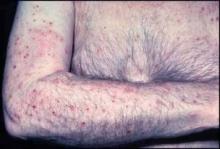NEW YORK – Bullous pemphigoid has a sharply increased incidence in the elderly, and can sometimes be challenging to diagnose because of atypical presentation.
Results from a recent review of 117 patients newly diagnosed with bullous pemphigoid (BP) in Switzerland during 2001-2002 showed that 20% of the patients had atypical manifestations. Among the patients with atypical BP, the time to a correct diagnosis rose by 50%, compared with patients who had typical presentations (an average increased time to diagnosis of 3 months), Dr. Luca Borradori said at the meeting.
BP "is an extremely polymorphic disease," he added. When it presents with classic, generalized bullous lesions it’s easily diagnosed, but when it is localized and presents with nonbullous lesions the diagnosis is challenging and often delayed, said Dr. Borradori, a professor of dermatology at the University Hospital in Bern, Switzerland. The elderly are so susceptible to BP that an aggressive approach to diagnosis works best.
"Always consider BP for elderly patients with relapsing, itchy, cutaneous lesions," he said.
His recommended diagnostic criteria include using direct immunofluorescence microscopy to identify linear deposits of IgG or complement component C3 in the epidermal basement membrane zone in patients with subepidermal blistering. Patients with these deposits should also have at least three of the following four criteria to receive a BP diagnosis: no atrophic scarring, no mucosal involvement, no head and neck involvement, and age older than 70 years. This approach had a positive predictive value of 95%, a sensitivity of 86%, and a specificity of 90%, Dr. Borradori said.
Patients with nonbullous lesions pose the hardest diagnostic challenge. These cases can present with eczematous and urticated lesions; scaly and crusted lesions; localized bullae, erosions, or vegetating lesions; persistent mucosal lesions; and lesions with skin fragility or atrophic scarring.
Dr. Borradori and his associates have documented the role of older age in boosting the incidence of BP. In their study of all new presenting BP cases in Switzerland during 2001-2002, they found an overall BP incidence of about 12 new cases/year for every 1 million people. But among men aged 70-79 the average annual rate jumped to roughly 175 new cases per 1 million people, and for those aged 80 or older the incidence rose to 250 new cases per 1 million people per year.
In contrast, among men or women 50-59 the annual rate ran less than 10 new cases per 1 million people, and among people younger than 50 years old the annual incidence barely rose above one new case per 1 million people.
The clear choice for treatment of mild or localized BP is potent topical steroids, as well as for extensive and persistent cutaneous disease. The oral corticosteroid prednisone was also validated for treating extensive and persistent cutaneous BP in a prospective randomized trial. However, no treatments have been proven in a trial to work for treatment-resistant and challenging cases. "Aggressive, non-validated therapies should be avoided," Dr. Borradori said. Blinded, randomized trials are "urgently needed" to investigate the efficacy of novel biologic therapies.
Dr. Borradori reported having no disclosures.


